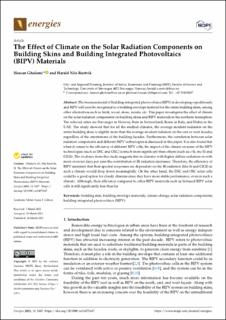| dc.contributor.author | Gholami, Hassan | |
| dc.contributor.author | Røstvik, Harald Nils | |
| dc.date.accessioned | 2021-05-03T06:54:51Z | |
| dc.date.available | 2021-05-03T06:54:51Z | |
| dc.date.created | 2021-03-27T00:03:08Z | |
| dc.date.issued | 2021-03 | |
| dc.identifier.citation | Gholami, H., Røstvik, H.N. (2021) The Effect of Climate on the Solar Radiation Components on Building Skins and Building Integrated Photovoltaics (BIPV) Materials. Energies, 14(7) | en_US |
| dc.identifier.issn | 1996-1073 | |
| dc.identifier.uri | https://hdl.handle.net/11250/2740698 | |
| dc.description.abstract | The business model of building-integrated photovoltaics (BIPV) is developing expeditiously and BIPV will soon be recognised as a building envelope material for the entire building skins, among other alternatives such as brick, wood, stone, metals, etc. This paper investigates the effect of climate on the solar radiation components on building skins and BIPV materials in the northern hemisphere. The selected cities are Stavanger in Norway, Bern in Switzerland, Rome in Italy, and Dubai in the UAE. The study showed that for all the studied climates, the average incident radiation on the entire building skins is slightly more than the average incident radiation on the east or west facades, regardless of the orientations of the building facades. Furthermore, the correlation between solar radiation components and different BIPV technologies is discussed in this paper. It is also found that when it comes to the efficiency of different BIPV cells, the impact of the climate on some of the BIPV technologies (such as DSC and OSC) is much more significant than others (such as c-Si, mc-Si and CIGS). The evidence from this study suggests that in climates with higher diffuse radiation-or with more overcast days per year-the contribution of IR radiation decreases. Therefore, the efficiency of BIPV materials that their spectral responses are dependent on the IR radiation (like Si and CIGS) in such a climate would drop down meaningfully. On the other hand, the DSC and OSC solar cells could be a good option for cloudy climates since they have more stable performance, even in such a climate. Although, their efficiency compared to other BIPV materials such as Si-based BIPV solar cells is still significantly less thus far. View Full-Text | en_US |
| dc.language.iso | eng | en_US |
| dc.publisher | MDPI | en_US |
| dc.relation.uri | https://www.mdpi.com/1996-1073/14/7/1847 | |
| dc.rights | Navngivelse 4.0 Internasjonal | * |
| dc.rights.uri | http://creativecommons.org/licenses/by/4.0/deed.no | * |
| dc.subject | energi | en_US |
| dc.subject | bygg | en_US |
| dc.subject | klimaendringer | en_US |
| dc.subject | solceller | en_US |
| dc.title | The Effect of Climate on the Solar Radiation Components on Building Skins and Building Integrated Photovoltaics (BIPV) Materials | en_US |
| dc.type | Peer reviewed | en_US |
| dc.type | Journal article | en_US |
| dc.description.version | publishedVersion | en_US |
| dc.rights.holder | Copyright: © 2021 by the authors | en_US |
| dc.subject.nsi | VDP::Teknologi: 500::Miljøteknologi: 610 | en_US |
| dc.source.volume | 14 | en_US |
| dc.source.journal | Energies | en_US |
| dc.source.issue | 7 | en_US |
| dc.identifier.doi | 10.3390/en14071847 | |
| dc.identifier.cristin | 1901428 | |
| cristin.ispublished | true | |
| cristin.fulltext | original | |
| cristin.qualitycode | 1 | |

